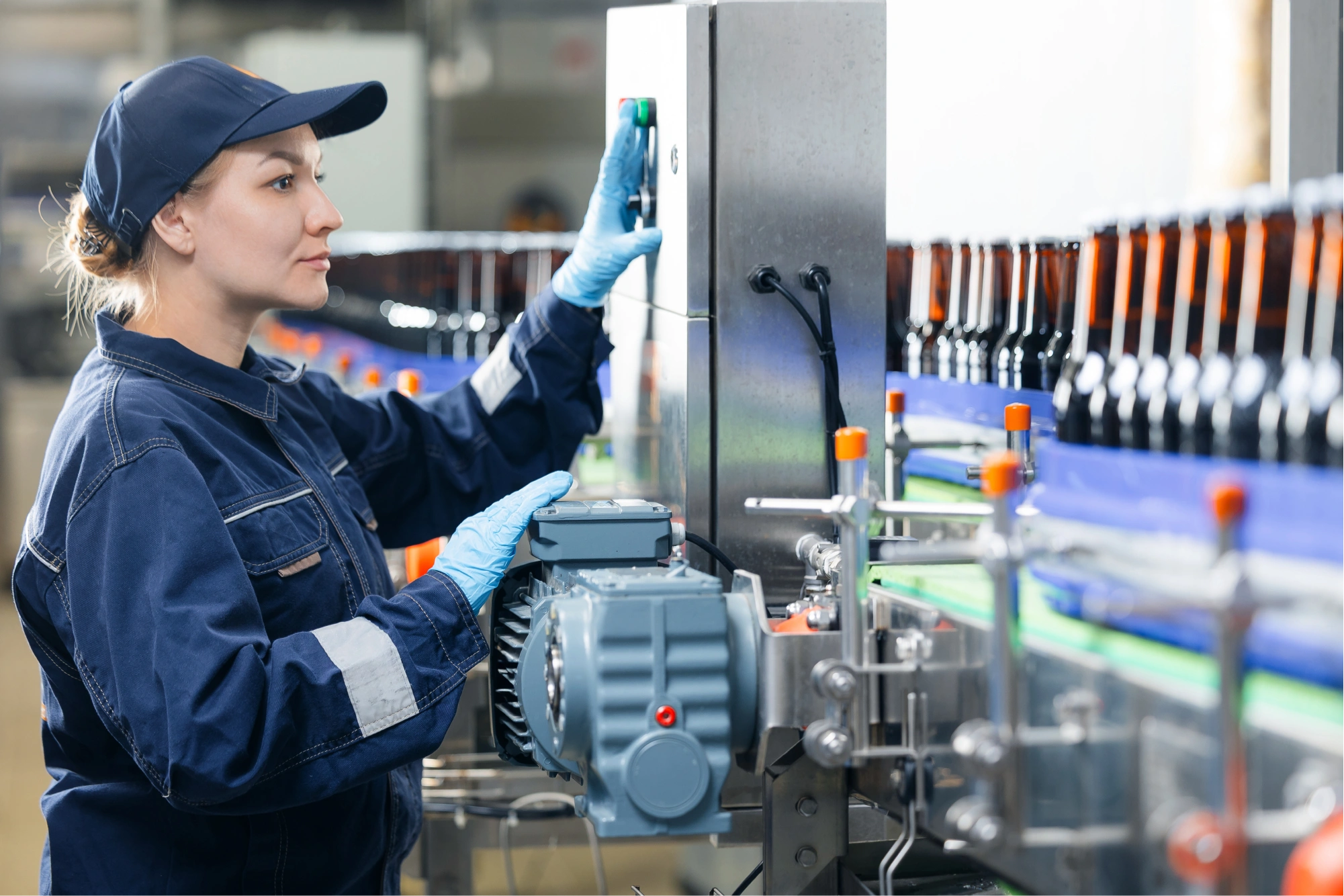Across manufacturing sectors, the time is ripe for industrial automation. A perfect storm of rising costs, regulatory demands, economic uncertainty, and a shrinking workforce have made digitization essential.
The process is simple, if a proper foundation is laid. Once teams see the value, the tech becomes indispensable.
Let's talk about daily life on the other side of this transformation, why predictive maintenance (PdM) is a key component, and how manufacturers are using PdM to conquer their biggest production challenges.
The smart factory in practice: a connected, optimized operation
A modern smart factory integrates Internet of Things (IoT) sensors, advanced analytics, and plant automation into every aspect of production. Equipment performance, quality checks, inventory levels, and maintenance activities all share the same real-time and historical data flow. Control systems adjust parameters like temperature or load automatically, while AI models learn and adapt from new data to improve predictions over time.
The impacts go beyond technology. Maintenance personnel gain valuable insights into potential equipment failures early, reducing stress and reactive firefighting. Budgets stabilize thanks to lower maintenance costs and fewer surprise outages. And leadership gains a competitive edge through faster delivery, higher product quality, and the ability to drive progress on corporate sustainability goals.
Why predictive maintenance is the smart factory’s secret weapon
Picture this: a calm factory floor where your maintenance personnel aren’t scrambling to fix a breakdown in the middle of the night. Wireless triaxial vibration sensors feed real-time data into cloud-based solutions, and artificial intelligence (AI) algorithms analyze it instantly to detect anomalies. Predictive analytics provide the resolution window. Actionable insights from a condition monitoring engineer (CME) appear on a dashboard before a problem can snowball into lost production.
This is the reality of today’s smart manufacturing operations—data driven, proactive, and resilient.
In a smart factory environment, predictive maintenance (PdM) is one of the most transformative tools available. It offers an unprecedented degree of visibility and empowerment. Facility teams can get ahead of potential failures, schedule maintenance precisely when it’s needed, and extend the life of equipment, turning unpredictable repair costs into planned investments and reactive chaos into optimal performance.
How predictive maintenance insights transform workflows and results
Predictive maintenance systems serve as the operational safety net that keeps everything running. Condition monitoring techniques such as real-time vibration monitoring and oil analysis provide a comprehensive view of asset health as well as the steps needed to resolve issues early in the failure curve.
- PdM platforms continuously gather sensor data on critical equipment, feeding the data to AI-powered predictive models.
- AI analyzes patterns and correlations in the data, applying machine learning algorithms to identify anomalies and predict potential failures, delivering maintenance recommendations ranked by risk.
- CMEs then validate alerts to filter out false positives, ensuring that maintenance schedules are optimized so the team avoids over-servicing or missing a critical warning.
- Work orders are automatically generated, thanks to a seamless integration between the CMMS and the PdM platform.
- CMEs offer prescriptive recommendations to support root cause analysis and guide teams to corrective action.
As they leverage AI analysis combined with predictive maintenance insights from an expert partner, maintenance teams can act on the right issues at the right time—avoiding unnecessary preventive maintenance while catching degradation early enough to prevent costly downtime and minimize wear and tear.
Human reliability experts who partner with facility teams are key to driving value through predictive maintenance. Our recent webinar Meet the Minds Behind the Monitoring: A Conversation with Our Condition Monitoring Engineers offers a behind-the-scenes look at how CMEs monitor the condition of assets, guide maintenance teams, and make asset saves and workdays easy. Watch the replay here.
Case study highlights reveal predictive maintenance in action
In every industry, critical rotating equipment is staying healthier, performing better, and delivering more value over an extended lifespan thanks to reliable data and analysis and a highly efficient PdM workflow.
Rolling mill gearbox save
- Industry: Metals and processing
- Problem: Elevated vibration readings from a gearbox suggested gear mesh wear
- Action: Vibration data combined with oil analysis data indicated presence of wear metals and low oil levels
- Result: Seals replaced and oil topped off during a planned interval, avoiding a full gearbox replacement and saving $50,000
Catastrophic fan failure avoided
- Industry: Food and beverage
- Problem: Real-time monitoring showed a rapid spike in both vibration and temperature—parameters like temperature exceeded safe operating conditions
- Action: PdM alert validated by a condition monitoring engineer (CME) prompted immediate shutdown and bearing replacement
- Result: 48 hours of downtime avoided, preventing $66,816 in lost production
Cone crusher motor save
- Industry: Mining and aggregates
- Problem: Gradual data analysis revealed increasing vibration trends tied to motor bearing wear
- Action: Planned motor swap during scheduled downtime
- Result: 24 hours of downtime avoided, saving $240,000
Press roll bearing replacement before failure
- Industry: Pulp, paper, and packaging
- Problem: AI detected and CME verified a slow increase in vibration amplitude and frequency content consistent with bearing defect development
- Action: Bearing was replaced during a planned maintenance window
- Result: 36 hours of downtime prevented, saving $180,000 in repair costs and lost production
What these PdM successes have in common
Across these scenarios, a mix of PdM capabilities set the stage for high-value outcomes.
- Early intervention: Anomalies identified far before potential equipment failures
- Data-driven decision making: Vibration, oil, and temperature monitoring combined in one platform
- AI + human oversight: Expert CMEs validating PdM system data and recommending next steps, preventing alert fatigue and boosting productivity and trust
- Lean-team efficiency: Less time chasing false alarms, more time on high-value optimization
This is smart manufacturing in action. The ease of achieving critical saves shows the power and importance of having advanced tools and technology, data-driven insights, and robust expert support. Check out these additional asset saves across a wide range of industries.
The ripple effects of PdM across industrial operations
A successful predictive maintenance program naturally breeds operational excellence and resilience.
- People: Reduced stress, overtime, and reactive maintenance, improving retention and morale
- Budgets: Turning unpredictable breakdowns into predictable, budgeted repairs
- Competitive edge: Consistent uptime keeps customers happy and production targets met
- Sustainability: Reduced waste and energy use through optimized maintenance schedules and extended equipment lifespan
AI + human-powered condition-based maintenance is key to resilience and growth amid volatility and uncertainty in the market. Our recent white paper Resilient Reliability: Why Predictive Maintenance Drives Value in Any Economy explains how you can achieve and sustain operational gains and advance corporate goals under any conditions. Download your copy today.
Plant automation through IoT, AI, machine learning, and expert insight: operational excellence made easy
Implementing an automated predictive maintenance workflow in an IoT- and AI-enabled facility doesn’t require a massive CapEx investment. End-to-end cloud-based solutions now bundle hardware, installation, condition monitoring, AI analysis, and expert oversight into a single subscription.
You can start simply, by targeting high-criticality assets and gathering predictive maintenance insights. Soon, you can prove ROI with clear metrics and scale your predictive maintenance systems across the plant. Integrating PdM with other smart factory tools—MES, quality control, and scheduling—maximizes its value.
A smart factory runs on the health of its assets—and predictive maintenance keeps that health strong. Want to see how it works in action? Connect with the AssetWatch team at SPS 2025 to explore how AI-powered condition monitoring can transform your operations.

















